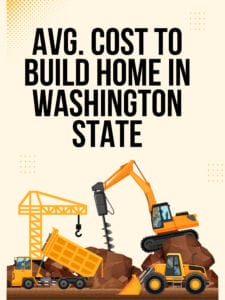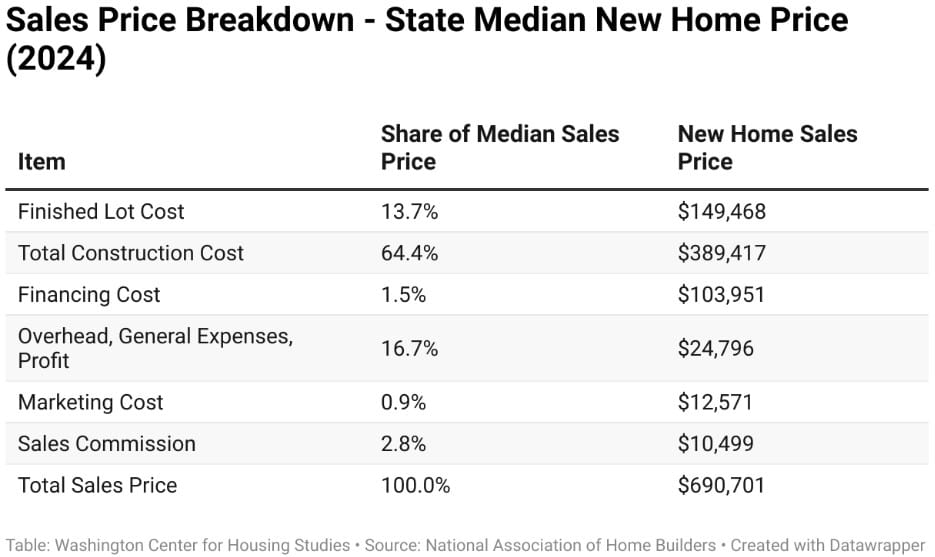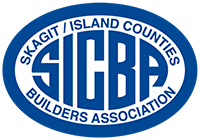
How Much Does It Cost to Build a Home in Washington State? (2025 Guide)
Thinking about building your own home in Washington? Whether you're dreaming of a cozy place in the woods or a modern house in the city, it's a big step—and one that comes with a lot of questions. One of the most common: How much does it cost to build a house in Washington State?
In this guide, we’ll break down the average costs, explain what factors affect pricing, and share some smart ways to save money along the way.
Quick Answer: In 2025, building a home in Washington will typically cost between $200 and $350 per square foot. For a 2,000-square-foot home, that adds up to around $400,000 to $700,000, depending on where you build and the choices you make.
Building a new home in Washington State is an exciting venture, but it's important to understand that costs can vary significantly depending on location, materials, labor, and design choices. According to the 2024 Cost of Constructing New Homes in Washington State report by the Building Industry Association of Washington, homebuilding costs continue to rise across the state, driven by factors such as regulatory fees, land prices, and material shortages. In this guide, we’ll break down what you can expect to pay—and highlight smart ways to save during the process.
What Impacts the Cost of Building a House in Washington State?
1. Land Cost and Location
The price of land is one of the biggest variables—and it varies dramatically across the state.
-
Urban lots, especially in King, Snohomish, and Pierce Counties (Seattle, Bellevue, Tacoma), can cost anywhere from $250,000 to over $500,000 for a standard residential parcel.
-
In rural counties like Okanogan, Stevens, or Lincoln, you may be able to find land for $40,000 to $100,000, especially if it’s undeveloped.
-
Other factors that affect land price:
-
Proximity to amenities (schools, stores, transit)
-
Waterfront or view properties
-
Zoning restrictions and land-use rules
-
Slope or soil conditions, which can increase the cost of grading and foundation work
-
Quick Tip: Always get a land feasibility study before purchasing to avoid surprise costs down the road.
2. Permits, Fees, and Local Regulations
Before construction begins, you’ll need to get several permits—and the costs can add up quickly.
-
Standard permits include:
-
Building permit
-
Mechanical, electrical, and plumbing permits
-
Septic system approval (if not on city sewer)
-
Shoreline or environmental review (for some locations)
-
-
Permit fees vary by city or county:
-
In Seattle, total permitting and impact fees can top $30,000+
-
In smaller towns or rural areas, fees are often closer to $5,000–$15,000
-
-
Some areas may also require:
-
Stormwater drainage plans
-
Energy code compliance documentation
-
Tree or vegetation assessments
-
Quick Tip: Check with your local planning department early. Fees, timelines, and requirements differ widely across jurisdictions.
3. Labor Costs and Availability
Labor costs are another major portion of your budget—often 30% to 40% of the total.
-
Washington’s construction industry faces a skilled labor shortage, particularly in growing urban areas.
-
Hourly rates vary:
-
General contractors: $50–$150/hour
-
Skilled trades (electricians, plumbers, framers): $65–$120/hour
-
Apprentices or helpers: $20–$40/hour
-
-
High labor demand can also mean longer timelines if your contractor is juggling multiple projects.
Quick Tip: Hire licensed and insured professionals who are local to your build site—this reduces travel charges and ensures they’re familiar with area-specific codes.
4. Material Prices and Availability
Materials are a constantly moving target due to market changes, supply chain delays, and inflation.
-
As of 2025, some material prices have stabilized, but they’re still 15–30% higher than pre-pandemic levels.
-
Common material costs and local suppliers here.
-
Lumber (framing): $25,000–$50,000 depending on home size
-
Roofing (asphalt shingles): $8,000–$15,000
-
Drywall: $10,000–$18,000
-
Concrete (foundation, driveway): $15,000–$30,000+
-
Windows & doors: $8,000–$20,000
-
Some materials (like high-efficiency HVAC systems or solar panels) come with upfront costs but can qualify for rebates or reduce long-term energy bills.
Quick Tip: Order materials early and try to source from local suppliers to avoid shipping delays and added freight charges.
5. Home Design, Layout, and Custom Features
The more customized your home is, the more you’ll pay.
-
Basic ranch-style or two-story homes with standard materials are the most cost-effective to build.
-
Custom designs that include:
-
Vaulted ceilings
-
Open staircases
-
Large window walls
-
Smart home integrations
-
High-end flooring or appliances
...can quickly drive your build cost above $350–$400 per square foot.
-
-
Square footage matters too. A smaller home with complex angles and finishes may cost more per square foot than a larger, simpler home.
Quick Tip: Consider using pre-drawn architectural plans or design/build firms to save on architectural fees and streamline the process.

Costs Many People Overlook
Some of the biggest surprises for first-time homebuilders come from the expenses they didn’t plan for:
-
Connecting Utilities: Bringing in water, power, internet, or adding a well/septic system can run $10,000 to $50,000.
-
Land Prep & Grading: Clearing trees or leveling the lot can cost $5,000 to $25,000.
-
Loan Costs: If you're using a construction loan, don’t forget about interest, loan fees, and closing costs.
-
Inspection Fees: Required at different stages of construction—and sometimes come with extra costs if something needs to be fixed.
Typical Costs for Different Home Types
Single-Family Detached Homes
-
Cost per Sq. Ft.: $309 average
-
Median Home Size: 2,505 sq. ft.
-
Estimated Total Cost: ~$775,000 (excluding land)
Townhomes
-
Cost per Sq. Ft.: $404
-
Estimated Total: ~$592,000
Custom Homes
-
Cost Range: $350 – $550+ per sq. ft.
-
2,500 sq. ft. Home Estimate: $875,000 – $1.4 million+
Average Homebuilding Costs by Region

How to Save Money When Building a Home
Building a home doesn’t have to break the bank. Here are a few tips to help keep costs under control:
-
Work with Local Builders
Builders who know the area can help you avoid delays, save on transportation, and make sure your project meets local codes. -
Stick to Simple Floor Plans
Tried-and-true layouts are faster to build and usually much cheaper than custom designs. -
Take Advantage of Green Building Rebates
Washington offers various rebates for energy-efficient upgrades, which can help reduce your upfront and long-term costs. -
Buy Materials Locally
This can cut down on delivery fees and help avoid delays caused by long-distance shipping. -
Bundle Services
If you can find a builder who handles permits, construction, and inspections, you may save money by keeping it all under one roof.
Why Work with a Local Builders Association?
Your local builders association is a great place to start when planning your home. They can help you:
-
Navigate the local building codes and permitting process
-
Get peace of mind knowing you're working with vetted professionals
Looking for a builder in Skagit or Island County? Start with SICBA—we’ll connect you with trusted pros who can bring your vision to life.
Frequently Asked Questions
Q: Is it cheaper to build or buy a home in Washington?
A: It depends. In rural areas, building may be cheaper. In cities, buying an existing home can sometimes save time and money.
Q: How long does it take to build a home?
A: On average, most home builds take 7–12 months, depending on the complexity and permitting process.
Q: Are there grants or incentives for building a home?
A: Yes—Washington offers several programs, especially for energy-efficient homes and first-time buyers. Check available programs here.

 Looking for a builder in Skagit or Island County?
Looking for a builder in Skagit or Island County?